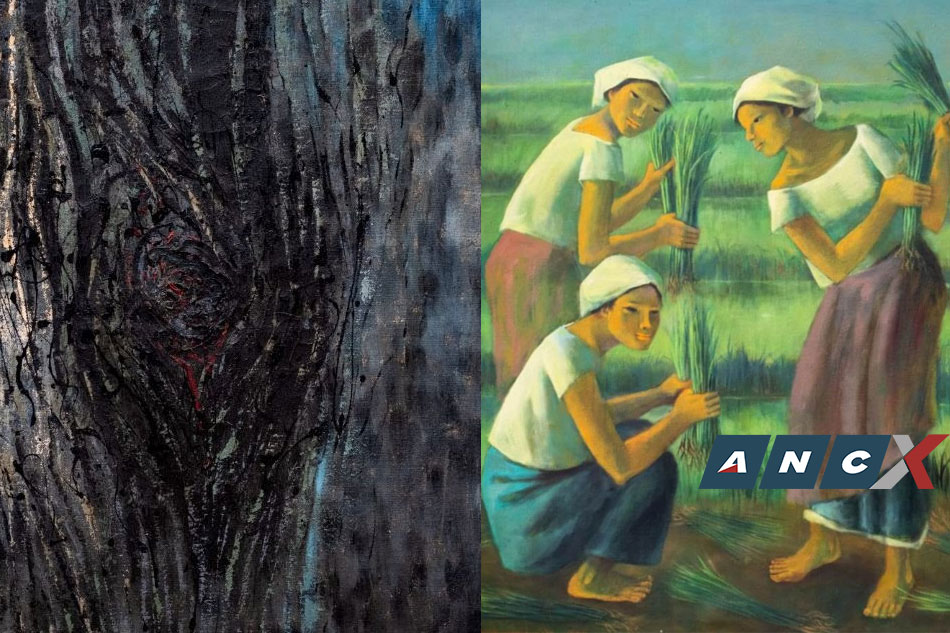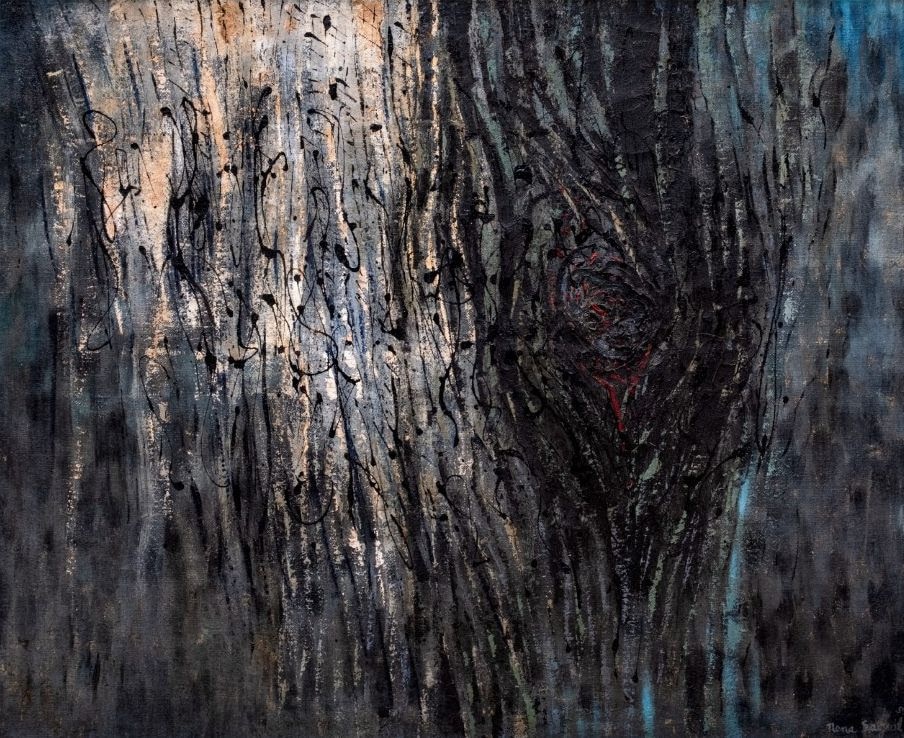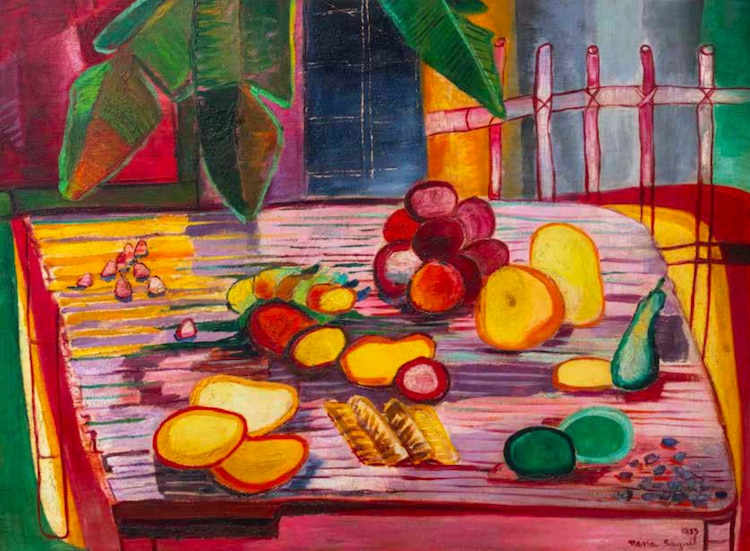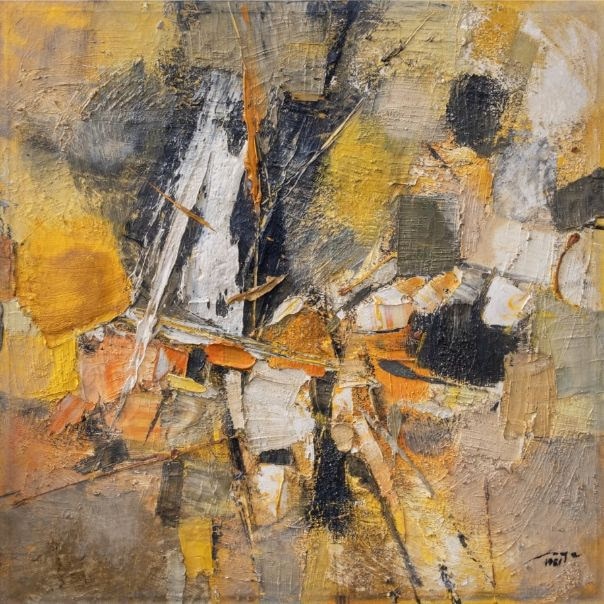As is fitting for Women’s Month celebration, important works by Anita Magsaysay-Ho and Nena Saguil will highlight Leon Gallery’s annual collaborative auction with the Asian Cultural Council (ACC) on March 9.
Magsaysay-Ho (1914-2012) is represented by “Planting Rice,” signed and dated 1950, oil on canvas, 36” x 30”. Saguil (1914-1994) is represented by the very stark oil-on-canvas abstraction, “Sans Titre (Untitled),” signed and dated 1959 (31.5” x 38.5”).
The two were classmates at the University of the Philippines' School of Fine Arts (they were just a few months apart by age, although Magsaysay-Ho was a little older). Magsaysay-Ho would later take up higher studies at Cranbrook Academy of Art in Michigan, while Saguil would go to Paris on a French government scholarship and stay there and live the life of an émigré artist till her death in 1994.
Incidentally Magsaysay-Ho and Saguil, both renowned Modernists, will be featured in the Venice Biennale 2024 International Art Exhibition.
The auction aims to raise funds for the ACC Fellowship Program, which facilitates cultural exchange opportunities for Filipino artists.
In "Planting Rice," the scene unfolds with three women meticulously preparing the rice for planting amid the muddy fields. One figure in the background confidently stands within the “pilapil,” poised to gently press the shoots into the soft earth, while the others delicately grasp the green stems, their movements evoking a graceful dance.
The color scheme, dominated by cool blues and violets, presents a tranquil contrast to Fernando Amorsolo's typically sun-drenched landscapes.
Amorsolo and Fabian de la Rosa had painted similar scenes, but for them, rice-planting symbolized more than just agricultural labor—it served as a metaphor for female fertility, embodying the archetype of the docile and supportive Filipina, the devoted companion of the farmer. She is depicted as silent, smiling, and self-sacrificing in their interpretations.
However, in Anita Magsaysay Ho's skilled hands, "Planting Rice" transformed into a narrative of resilience and empowerment. She portrayed women as strong and independent, capable of navigating life's challenges without constraints.
As the Philippine art scene marks Ho's 110th birth anniversary, she has emerged as a pioneering figure among the Filipino Modernists, her rendition of "Planting Rice" serving as a poignant symbol of female strength and achievement.
Émigré artist in Paris
Saguil’s untitled abstract work likewise appears as an “agricultural” piece, seeming to ape the craggy texture of an old and weathered but still formidable trunk of a tree.
The stark naturalism of the piece may owe to the “abstraction lyrique” (lyrical abstraction) she had learned from her French mentor, Alfred Mannesier, a non-figurative artist from the new School of Paris, where she studied.
In an interview with Cid Reyes, Saguil coined the term "Lyrical Cubism" to encapsulate her series of artworks, describing them as squares floating in various tones.
According to Reyes and the critic Leo Benesa, Mannesier played a pivotal role in shaping Saguil's spiritual journey. With the fervor of a recent convert, the French artist delved into mysticism, sacred art, and the expression of spiritual ecstasy — themes that increasingly permeated Saguil's work.
The pursuit of the divine finds expression in "Composition en Noir et Blanc (Composition in Black and White)" (1958), another famous piece by Saguil.
Art critic Rod Paras-Perez said Saguil had mastery of black, equating its richness to that of any color in the rainbow.
In "Sans Titre (Untitled)" (1959), Saguil delved deeper into experimentation, employing heavy impasto and intricate layers that evoke mystery and density, reminiscent of Jackson Pollock's drip paintings.
This transitional masterpiece seems to propel her towards future artistic galaxies, showcasing her evolving style.
Saguil often described her art as "intuitive," a means of connecting with God and the cosmos. The circular patterns within her work serve as both mandalas and molecules, symbolizing the interconnectedness of self and universe.
Benesa, captivated by Saguil's transcendent art, lauded her ability to traverse the temporal and spatial confines of Manila and Paris, quenching the collective thirst for the absolute through her alchemic creations.
Another Saguil work in the auction is an even earlier piece and shows the influence of Paul Gauguin. “Still Life No. 2,” signed and dated 1953 (oil on masonite board; 17 1/2" x 23 3/4") is a historic piece since, according to the auction catalogue: it travelled to the United States to be part of the landmark Philippine Cultural Exhibition, featuring 21 of the Philippine Art Gallery’s (PAG) roster.
“It was originally in the collection of PAG founder, Lyd Arguilla, making it doubly historic,” declares the catalogue.
According to French art critic in his monograph, “The Illuminations of Nena Saguil,” she “debuted in the Philippines under the aegis of Gauguin (and) assimilated his rhythm and accepted his rules.” “Gauguin is for this Oriental an example of harmonious order and a point of focus,” he added.
Diverse
Curated by ACC partner and Jaime Ponce De Leon and his team at Leon Gallery, the auction boasts an extraordinary collection of artworks reflecting the diverse heritage of Philippine artistry.
"Through the sale of these artworks,” Ponce de Leon said, “we aim to support the ACC's mission of fostering cultural exchange and providing opportunities for Filipino artists to showcase their talent on the global stage."
Ernest Escaler, chairman of ACC Philippines, praised the partnership with Leon. "The proceeds from this auction will directly benefit the ACC Fellowship Program, providing vital support for artists to engage in cultural exchange and expand their artistic horizons," he said.
ACC grant recipients last year included choreographer Japhet Mari Cabling, multi-disciplinary artist Corinne De San Jose, and composer Maria Christine Muyco.
Additionally, works from art patrons such as Don Geny Lopez, Don Jorge Vargas, Gen. Carlos P. Romulo, and Ambassador. Conlu Hernaez will be highlights of the event.
Among the auction's highlights are pieces by Filipino art icons Juan Luna and Felix Resurreccion Hidalgo, including Luna's poignant "Ecce Homo" and "Landscape in Bilbao," as well as Hidalgo's lyrical work "Idilio."
Former ACC grantees Jose Joya and Roberto Chabet will also have significant pieces up for auction, showcasing the transformative impact of ACC support on Filipino artists' development.
Other highlights include works by Fernando Zobel and National Artists H.R. Ocampo, Fernando Amorsolo, and Cesar Legaspi.
The Asian Cultural Council Auction 2024 will start at 2 p.m. on March 9 at León Gallery, located at Eurovilla 1 Rufino and Legazpi streets, Legazpi Village, Makati City.
For more information about the auction, visit www.leon-gallery.com. To learn more about ACC Programs, visit www.asianculturalcouncil.org.







